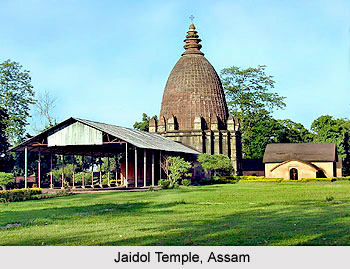 Tais of Upper Burma in 1228 A.D. captured the political power and they were known as Ahoms. Majority of the stone sculptures discovered in the Ambari excavation in the heart of Guwahati bear the characteristic features of the pre-Ahom or Pala style of Assam but certainly not in Ahom style. These sculptures belong to the 13th-14th century. The famous Nataraja also bear some elements in its pre-Ahom style. In case of terracotta sculpture there is no decadence in style. By the 17th century there was a revival in the sculptural art of Assam. The rulers also extended their support to temple building activities. The walls of these temples were decorated with sculptured images. The temples from 17th century have yielded sculptures of the pre-17th century periods characterized by local Ahom style. Brahmanical deities were done by the Ahom-Koch artists who were not well-versed in the classical Sanskrit tradition of the Palas. Therefore they are infused with folk elements.
Tais of Upper Burma in 1228 A.D. captured the political power and they were known as Ahoms. Majority of the stone sculptures discovered in the Ambari excavation in the heart of Guwahati bear the characteristic features of the pre-Ahom or Pala style of Assam but certainly not in Ahom style. These sculptures belong to the 13th-14th century. The famous Nataraja also bear some elements in its pre-Ahom style. In case of terracotta sculpture there is no decadence in style. By the 17th century there was a revival in the sculptural art of Assam. The rulers also extended their support to temple building activities. The walls of these temples were decorated with sculptured images. The temples from 17th century have yielded sculptures of the pre-17th century periods characterized by local Ahom style. Brahmanical deities were done by the Ahom-Koch artists who were not well-versed in the classical Sanskrit tradition of the Palas. Therefore they are infused with folk elements.
Features of Ahom Sculpture
Ahom artists were ignorant of Hindu iconography due to which they committed some mistakes in producing the figures of Hindu divinity. For instance the temple near Kuwarital has an image of Lord Vishnu carved in imitation of Pala sculptures but it lacked their proportion of limbs, balance of structure and rhythm of lines. Nevertheless it is not subdued by folk elements unlike other Ahom sculptures on temple walls.
There is a Janardan temple at Sukresvara in Guwahati. It has an image of Vishnu in seated posture. The stone sculptures of the Ahom style have been characterized by peculiar sitting postures of the deities while riding an elephant or a horse. Dance and other secular themes are rarely depicted in the Ahom sculptures.
The stone temple at `Dah Parbatia` situated near Tezpur is a unique example of the artistry of ancient Assam. The door frame of the `Dah Parbatia` temple showcases the influence Gupta age. The Ahoms brought their own sense of structure. Bricks were introduced during the `Tung Khungia` period of Ahom reign. Umananda Temple, build by the Ahom King Gadadhar Singha is the earliest brick-built structure. Rudra Singha constructed the `Joy-Dol`; Siva Singha and `Siva-Dol`. Another well known historical monument is the `Kareng-ghar` that was constructed by Pramatta Singha.
The door-frame of the Dah-Parbatia Temple that bears two exquisite images of Ganga and Yamuna is considered as the most outstanding example of the ancient Assamese sculpture. Another example of this style is found in the `dvarapalas` on a huge boulder at Bargoan. These sculptures represent gods, goddesses and semi-divine figures. The representation of the `yaksa` and the `yakisini` were made to serve as special attendants to the deities sculptured on the wall of temples. The ceiling slab bears an embossed lotus.
Dancing figures form another set of sculptures that form the integral part of temple decoration. Dancing postures expresses the act of worship, thanksgiving, praise, supplications and humiliation. The temple`s walls were decorated with sculptures depicting various scenes from the Epics. Animal carvings are also present on the walls and ceilings of temples.
The art of stone sculpture in Assam was, however, still later not earlier than the 1st century B.C. or even 1st century A.D. when at a place called Sri Surya Pahar some votive stupas, i.e. small sized stupas in round were carved out of solid rocks.
The Ahom period started with a dull note but gained momentum in the late phase of Ahom-Koch period. They laid emphasis on folk elements and techniques.



